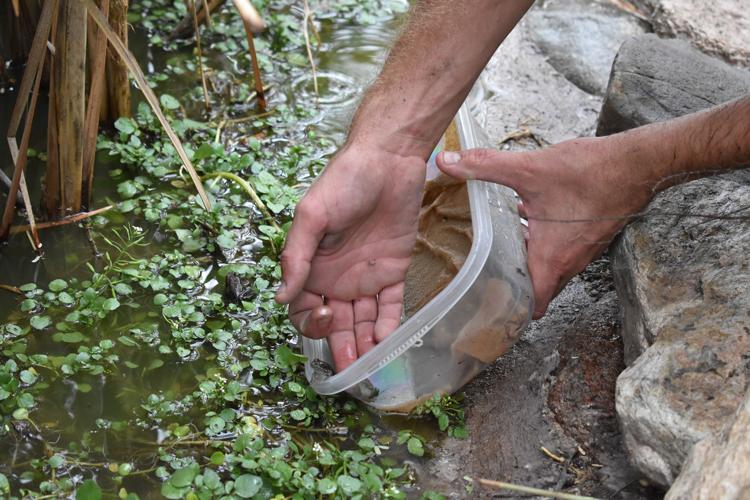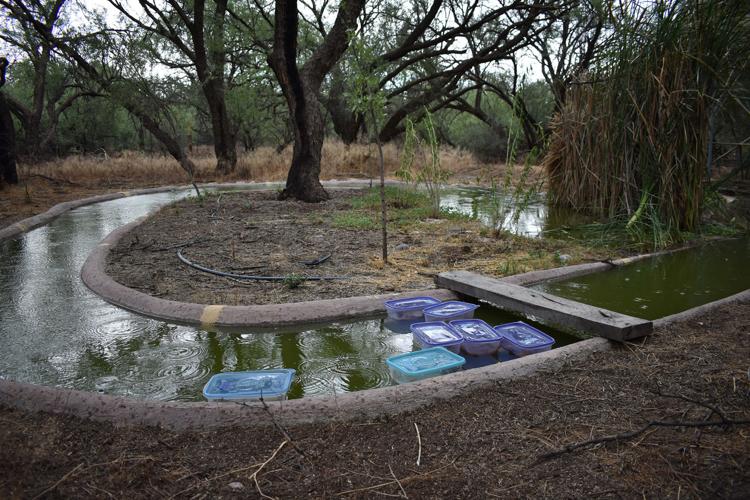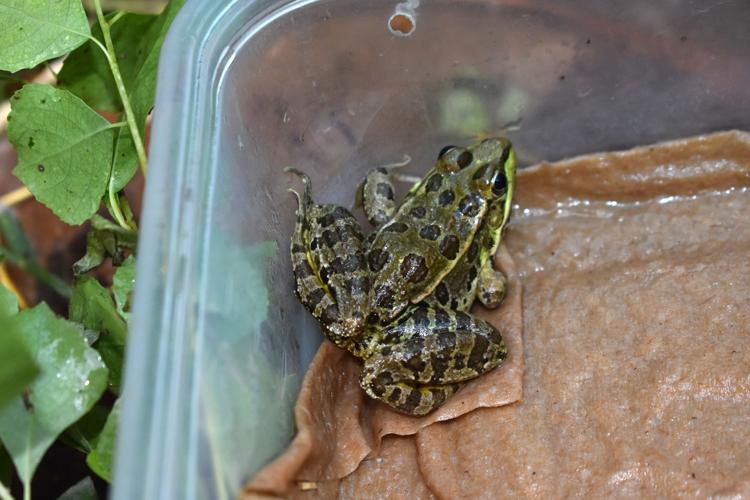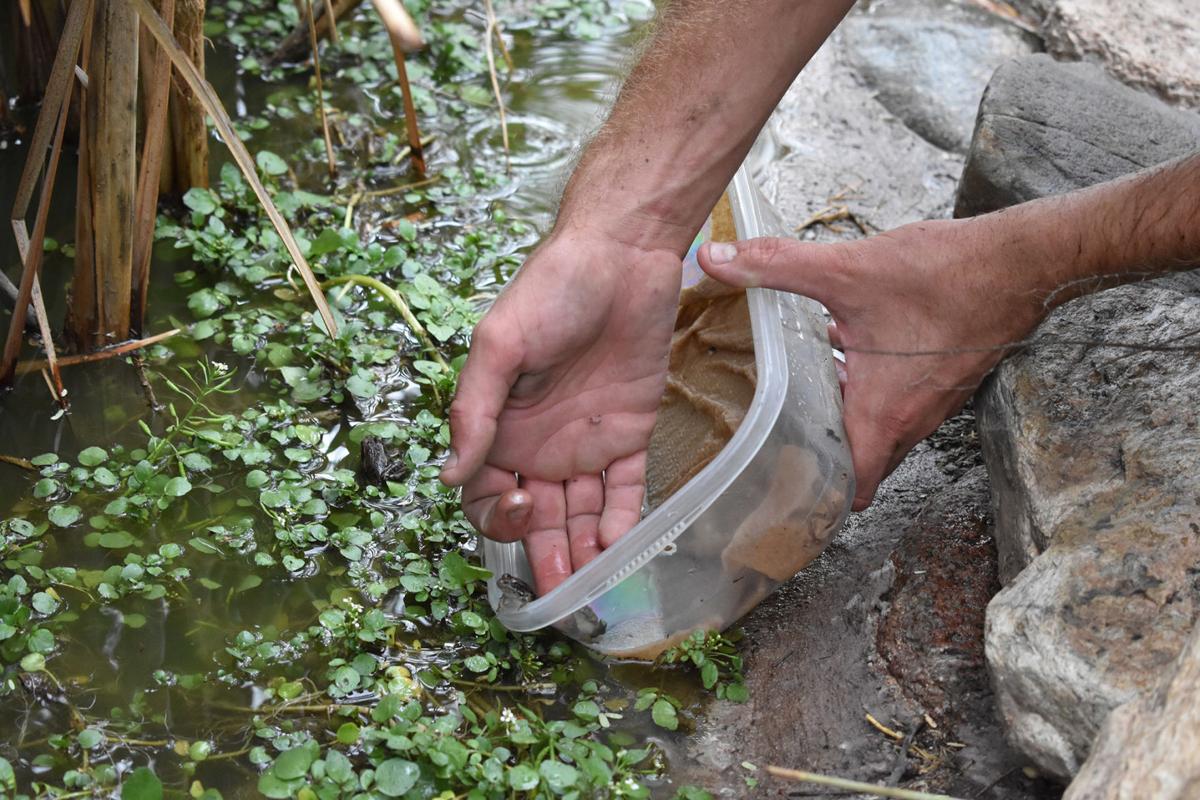Wildlife officials have found new spots for some leopard frogs whose home in the Catalina Mountains is threatened by flooding from the Bighorn Fire.
Close to 100 lowland leopard frogs were captured and removed from three canyons on the east side of the range during separate salvage operations over the past two weeks. The goal is to create backup populations in case the remaining frogs in those canyons get wiped out in coming years.
“We don’t want to put all our frogs in one basket,” said Ian Murray, a conservation biologist who manages Pima County’s ecological monitoring program.
The fear is that rocks and debris from the burned area will wash down into the canyons, filling the pools the frogs rely on during the hottest, driest part of the year.
Storm runoff laden with black ash also poses a threat because it could absorb more sunlight and heat up the frogs’ pools, effectively cooking their tadpoles, Murray said.
Wildfires such as the Bighorn Fire north of Tucson leave the ground charred and unable to absorb water, which can increase flood risks. “Even a light rain can produce devastating flash floods and mudflows, often with little warning,” Pima County officials warned. In this July 2020 video, a debris flow oozes down the Cañada del Oro Wash.
The frog roundup was conducted by staff members from the Arizona Game and Fish Department, the U.S. Fish and Wildlife Service, the U.S. Forest Service, Pima County’s Office of Sustainability and the Cascabel Conservation Association.

Lowland leopard frogs were released into a stock pond at a ranch as part of a salvage operation in Buehman and Bullock canyons on the east side of the Catalina Mountains.
On July 10, the team removed 50 frogs from Edgar Canyon and placed them in a stock pond at a ranch about a half mile away.
Murray was part of a second group that went out on Wednesday to net another 43 frogs from Buehman and Bullock canyons and release them into a private pond in Cascabel, about 13 miles away. The evacuees were placed in Tupperware containers and stacked inside coolers lined with ice to keep them cool and calm during transport.
All of the frogs survived the move. “Game and Fish has the procedure down pat,” Murray said.
The lowland leopard frog is not federally endangered, but it is protected at the state level, Murray said. The county considers it a species of conservation concern.
Many of its native creeks and rivers have been pumped dry over the past century or so, while non-native bullfrogs and green sunfish have moved in to prey on it.

The lowland leopard frog is not federally endangered, but is protected at the state level, said biologist Ian Murray. Pima County considers it a species of conservation concern.
“This species has really been subject to an onslaught on very many sides for decades and decades,” Murray said.
Today, the frog’s habitat in the Catalinas has been reduced to a handful of isolated creeks and pools, mostly on the east side of the mountains.
This marked the second rescue operation for sensitive species threatened by the Bighorn Fire.
In June, wildlife officials collected almost 900 endangered Gila chubs from Sabino Canyon to protect them from flood debris from the burned area above them. The fish were transplanted into several man-made habitats around the Tucson area.
As of Friday, the Bighorn Fire had burned almost 120,000 acres and was 90% contained.
Photos: Community Food Bank hosts Drive-up Farmer's Market
Santa Cruz River Drive-up Farmer's Market
Updated
Andreas Anderson, community foods coordinator, places an order in the trunk of a customer's car during the Santa Cruz River Drive-up Farmer's Market by the Community Food Bank of Southern Arizona near the Mercado District on July 16, 2020.
Santa Cruz River Drive-up Farmer's Market
Updated
Victor Ceballos, garden education coordinator, says he loves to chat with customers as they wait to place an order for produce during the Santa Cruz River Drive-up Farmer's Market by the Community Food Bank of Southern Arizona near the Mercado District on July 16, 2020.
Santa Cruz River Drive-up Farmer's Market
Updated
Rick Rosenberg plays "It's You I Like" by Mr. Rogers on his ukulele as he waits to place an order for produce during the Santa Cruz River Drive-up Farmer's Market by the Community Food Bank of Southern Arizona near the Mercado District on July 16, 2020.
Santa Cruz River Drive-up Farmer's Market
Updated
Andreas Anderson, community foods coordinator, hands a bag of produce through a customer's car window during the Santa Cruz River Drive-up Farmer's Market by the Community Food Bank of Southern Arizona near the Mercado District on July 16, 2020.
Santa Cruz River Drive-up Farmer's Market
Updated
Andreas Anderson, community foods coordinator, erases tomatos from the white board after running out of them to sell during the Santa Cruz River Drive-up Farmer's Market by the Community Food Bank of Southern Arizona near the Mercado District on July 16, 2020.
Santa Cruz River Drive-up Farmer's Market
Updated
Andreas Anderson, right, community foods coordinator, takes an order from a customer during the Santa Cruz River Drive-up Farmer's Market by the Community Food Bank of Southern Arizona near the Mercado District on July 16, 2020.
Santa Cruz River Drive-up Farmer's Market
Updated
Cora Varas, a volunteer, double checks the order with a customer during the Santa Cruz River Drive-up Farmer's Market by the Community Food Bank of Southern Arizona near the Mercado District on July 16, 2020.
Santa Cruz River Drive-up Farmer's Market
Updated
Cora Varas, a volunteer, works on fulfilling a customer's order and then bringing it to their car during the Santa Cruz River Drive-up Farmer's Market by the Community Food Bank of Southern Arizona near the Mercado District on July 16, 2020.







